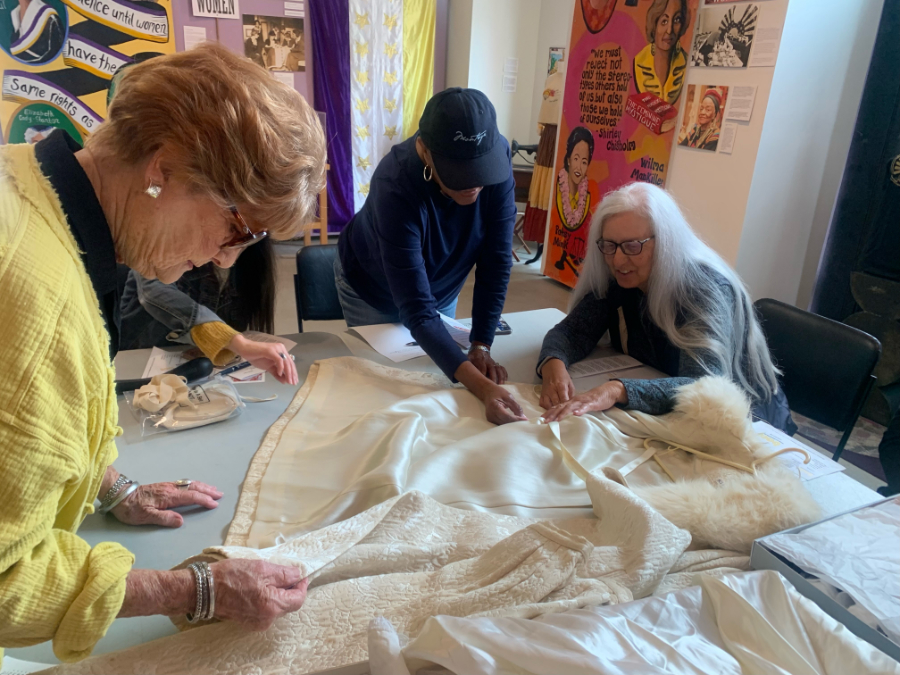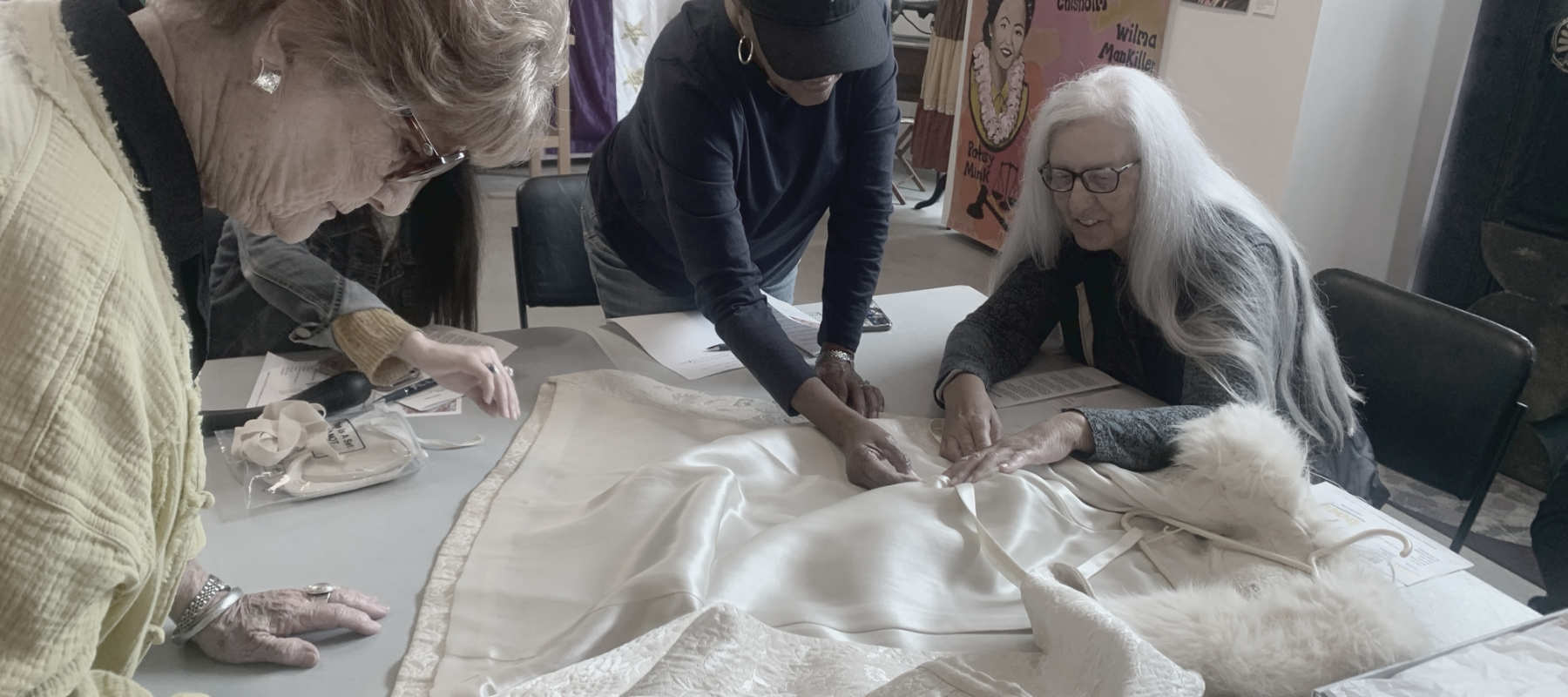Textile and preventive conservation often go hand-in-hand, as preventive considerations are essential in ensuring the safe display, mounting, and storage of textiles. Because textiles are ubiquitous in personal collections (go look in your closet for your favorite sweater or on your couch for your favorite blanket), everybody can be engaged in the preventive care of textiles.
Thus, textile conservators have a unique position to empower everyone to be engaged in conservation within their homes, deconstructing existing barriers between conservation knowledge and the public.
Balboa Art Conservation Center (BACC), located in San Diego, CA, is the only nonprofit regional conservation center in the American West. The collections and communities within its service area are incredibly diverse and encompass an array of textile types and traditions.
As the Kress Conservation Fellow and first textile conservator on staff at BACC, Annabelle Camp saw an opportunity to collaborate with BACC member institutions and underserved collections in the San Diego region to highlight the importance of preventive conservation in textile collections. Support from the Conserv Preventive Conservation Award allowed her to develop didactics essential to the teaching process.
A didactic kit for home textile collections by the Balboa Art Conservation Center
The didactic kit includes Gaylord Archival sample materials necessary for at-home textile care.
These include archival boxes, materials for padding and folding textiles for storage, such as acid-free tissue, and polyester batting, and supplies for constructing padded hangers. Safe alternatives to commonly accepted archival materials are also included. These include polystyrene bins and muslin sheeting.
Having affordable and sustainable options for participants was essential in ensuring the workshop was approachable and accessible.

Kress Conservation Fellow, Annabelle Camp, running the Balboa Art Conservation Center workshop about textile conservation practices for the Women’s Museum of California. Image courtesy of the Women’s Museum of California.
The didactic kit was first developed and used during a workshop with the Women’s Museum of California. The event coincided with the museum’s exhibit Crafting Feminism, which highlighted the role of textiles in women’s activism.
The workshop began with a lecture that introduced the participants to the field of textile conservation and the intersections of preventive and interventive care. The lecture outlined proper climate controls and pest identification and mitigation methods, highlighting best at-home methods for regulating fluctuations in relative humidity and temperature and how to keep pests at bay.
Following the introductory lecture, participants were guided through the didactic kit and samples of properly housed textiles
Best methods for folding textiles and hanging costumes were demonstrated. As part of the folding exercise, participants were shown how to pad folds using both archival tissue and snakes of polyester wadding covered with stockinette. The Women’s Museum of California kindly provided a wedding dress and jacket and skirt ensemble from their study collection for participants to discuss specific condition concerns and best methods for long term display and storage. In addition to materials for padding and folding, participants had the opportunity to create padded hangers using plastic wide-shoulder hangers, padded with polyester felt and covered with cotton stockinette.
Workshop participants included art handlers, textile makers, collectors, and enthusiasts. They each brought unique perspectives on the value of textile collections and their long term preservation. They each left with knowledge of textile care and accessible and affordable methods for implementing it.

Workshop participants examining a jacket and skirt ensemble from the Women’s Museum of California study collection. Image courtesy of the Women’s Museum of California.
A resource for the future
Now that a didactic kit is developed, this workshop can become a routine offering in BACC’s programming, potentially being offered at institutions or organizations throughout its service area, which includes the entire west coast, Arizona, New Mexico, Hawaii, and Alaska. In July, Annabelle used the kit as part of a lecture given at the Mingei International Museum, allowing attendees to feel and see the housing materials referenced in the talk.
Attendees clearly benefited from being able to engage with the materials, feeling the physical characteristics of materials such as Tyvek®, muslin, and twill tape firsthand and gaining a better understanding of how they can be used in their home collections.
This work meets a unique need within San Diego and the broader region, as there has historically been a dearth of textile conservators, despite large institutional and private needs. The workshop is one part of an ongoing transformative shift at BACC.
As the only regional center west of Minnesota, Balboa Art Conservation Center acknowledges its profound responsibility to provide conservation education and services to all communities in its service area, particularly those historically underserved by the field and underrepresented in museum collections.
Conservation for collections and communities
BACC is committed to shifting the way regional centers engage with collections and communities.
Balboa Art Conservation Center staff have undertaken various inclusive programs and broadened the organization’s role by supporting training opportunities, partnering with stewards of community collections, and learning from caretakers of diverse cultural heritage and ancestral collections.
Historically BACC only provided paper and paintings conservation. The addition of textile conservation services is part of a larger expansion to also include objects and preventive conservation. This expansion is necessary to fulfill the mission of preserving the cultural heritage of all communities. This workshop highlights BACC’s expanding work and shifting practice.
If you have any questions about environmental monitoring, integrated pest management, or just want to talk about preventative conservation for libraries and archives, please reach out to us! Don’t forget to check out our blog or join our community of collections care professionals where you can discuss hot topics, connect with conservators or even take a course to get familiar with the Conserv platform.




